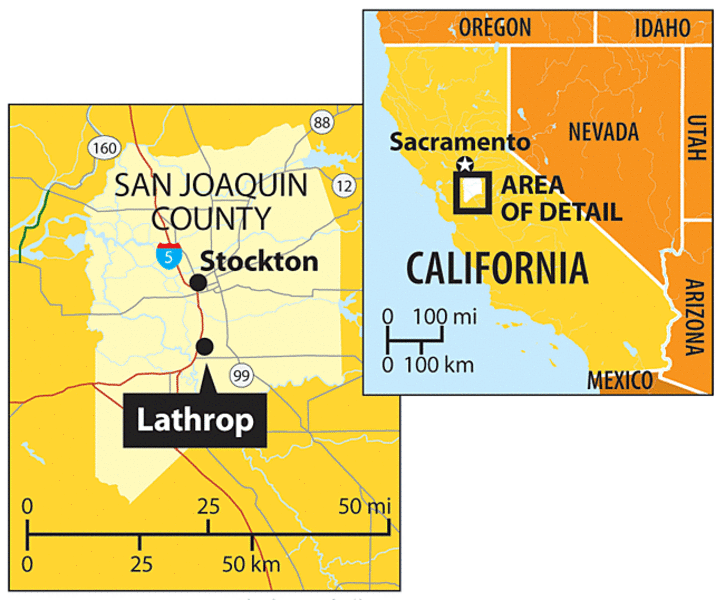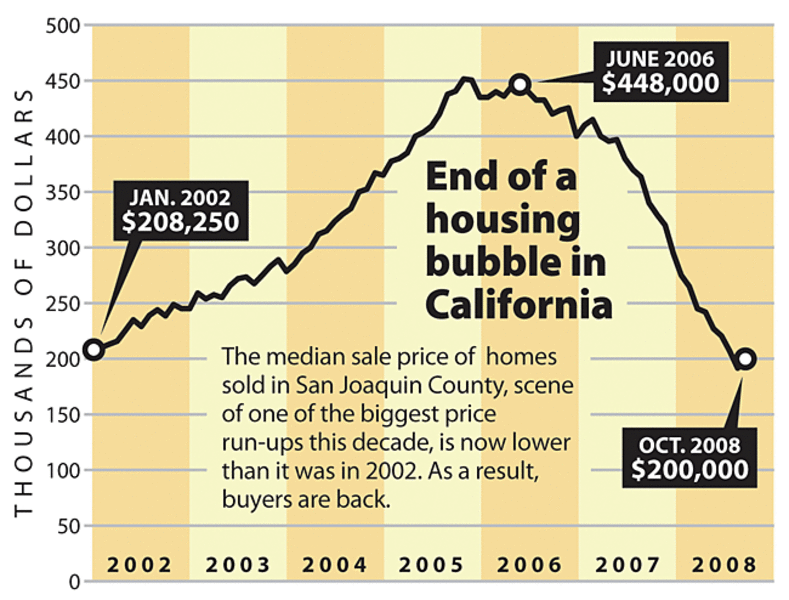Home buyers stirring in some markets
| Lathrop, Calif.
The housing market in California's Central Valley – and in other sharply deflated markets in parts of California, Nevada, Florida, and Arizona – is showing signs of new life.
Prices have fallen so far that people of average salaries can afford to own homes again. Buyers are out in force.
Here in Lathrop, Calif., and in nearby Stockton – the nation's foreclosure capital – home prices could be bottoming out. However, real estate agents remain wary given the number of vacant homes and expectations of more to be listed early next year.
"The buyers are returning. And in such a strong way that, now, we are hearing in some cases there is multiple bidding, which hints that maybe pricing is reaching a bottom point," says Lawrence Yun, chief economist with the National Association of Realtors (NAR). "But inventory remains high. There is a lot of conflicting information."
Stockton had to give back much of the housing bubble's price gains before buyers returned. In regions where prices haven't fallen so dramatically, sales remain slow, says Mr. Yun. Those areas may face the heavier downward pressure on prices going forward.
Whether real estate prices plunge further may also depend on how forcefully the next wave of foreclosures hits.
Already, banks have delayed foreclosures, hoping the new Obama administration will offer aid or work out programs that would benefit bankers' bottom line.
If it doesn't, a wave of new bank-owned listings could overwhelm the real estate market and send it tumbling again.
For now, it seems to be stabilizing here. Since April, monthly sales activity has grown over the previous year in San Joaquin County, according to DataQuick. Sales in September and October were at levels not seen since 2005 – near the height of the bubble frenzy.
New buyers are primarily first-timers and investors. A recent NAR survey found 20 percent of buyers are investors, but Stockton-area real estate agents put the investor share at one-third or more.
Some renters buy their first house
One first-time buyer, Christine Amy, has an offer accepted on a bank-owned home in Lathrop, a town in California's San Joaquin County.
"I'm a single parent with a bunch of kids, working part time going to school, and I'm just, like, there's no way [I could buy a home]. And 12 months ago, there wouldn't have been any way, even though I had three jobs at the time. The market was just too high," says Ms. Amy.
For $166,000, she was able to get a two-story, four-bedroom home in decent shape. Many foreclosed homes Amy looked at were "just completely thrashed." With most of the homes she did like, she lost out to other bidders. Some investors are able to undercut competition by simply offering cash.
Her real estate agent, Jim Muthart, says the type of buyer depends heavily on price. He scrolls down a list of 43 homes he's sold over the past eight months, ranked by price. Investors snatched up the first third of the list – the cheapest homes – to turn into rentals.
A switch happens at the $170,000 price point: Those buyers are purchasing the home to live in. Most are first-time buyers until he reaches the highest-end properties, which were bought by people wanting a bigger home and planning to rent out their current one.
The $170,000 turning point, explains Mr. Muthart, represents the most an investor putting down 20 percent can spend if he is to come out in the black each month given local rents. Rents have an upper boundary beyond which potential renters are shopping to buy instead.
"The investors are creating logic to the whole process because prices aren't going to drop down [endlessly since investors] can make money at a certain number," says Muthart.
The pricing floor provided by these investors, however, has broken through several times when the number of new listings exceeded the ability of investors to absorb them, he says.
Few big-time investors
Most investors in San Joaquin County are locals – doctors and farmers and retirees – according to half-adozen real estate agents interviewed. Some agents have dealt with a few foreign buyers and big-time investors picking up dozens of properties, but those are exceptions.
"It's a mixed bag of types of investor buyers. It's the couple down the street that has a nice nest egg and who want to put it into something that will give them a good return," says Bev Marlow, head of the Central Valley Association of Realtors.
Investments in places like Stockton can compare favorably with other investment options right now, with a volatile stock market and certified deposits that yield 3 percent, says Sean O'Toole, head of foreclosureradar.com, a website that tracks foreclosures.
Strong rent prices are key to a good return, and rents have softened recently, says Muthart. But there is still a steady stream of renters coming from foreclosed homes.
"Renters are becoming homeowners, and homeowners are becoming renters," says Muthart.
But don't assume each foreclosure equals a new renter, argues Caroline Latham, CEO of RealFacts, a rental data-tracking firm. Many families who are foreclosed on will move in with another family or move to a cheaper region, not rent.
"We are seeing a return to the notions that [investors] had in 2005," warns Ms. Latham, referring to the buying frenzy in the run-up to the housing bubble peak. "They think they'll be able to rent it and come out smelling good."
Foreclosures may rise again
The other concern for any potential buyer is whether home values will drop much further.
Prices showed a slight gain in October over September in San Joaquin County. They might be firmed up further by a dip in new listings. Since February, every month has brought roughly 1,000 new listings in Stockton but November is suddenly down to 672, says Joellen Chappell, a Stockton real estate agent.
At the same time, many experts here expect listing activity to spike early next year. Banks have only temporarily slowed the movement of bad loans toward sales, perhaps, speculates Ms. Chappell, to grab a bigger slice of any federal bailout.
Oversupply doesn't help prices, but helping prop them up is the return to affordability.
Mr. O'Toole sees equilibrium returning with the median income in California now qualifying for affordable loans just above the median home price.
Stockton median prices, says O'Toole, have dropped even further relative to income. "At this point, I don't think you'll see more price declines in Stockton."








